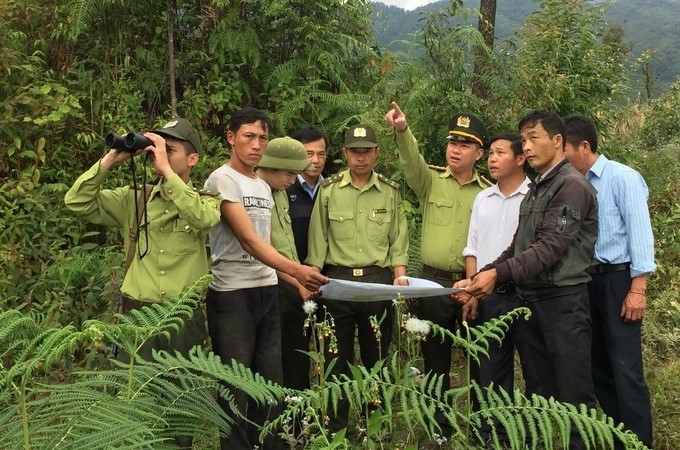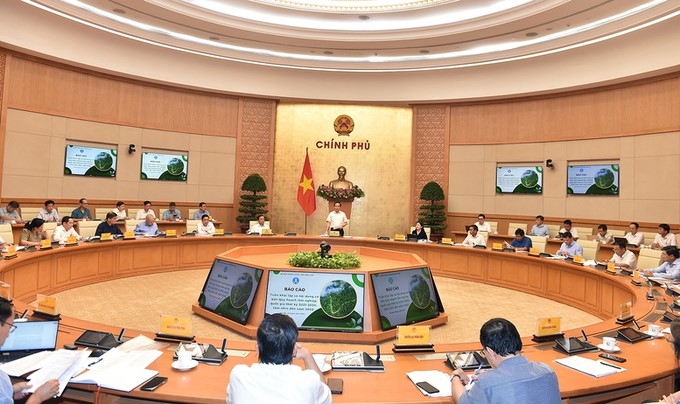December 8, 2025 | 06:36 GMT +7
December 8, 2025 | 06:36 GMT +7
Hotline: 0913.378.918
December 8, 2025 | 06:36 GMT +7
Hotline: 0913.378.918

Forest rangers coordinate with people to patrol the forest. Photo: Yen Bai Provincial Forest Protection and Development Fund.
The Forestry Planning for the 2021–2030 period aims to ensure the maintenance of a stable national forest coverage rate of 42–43% and focus on improving forest quality, especially existing natural forests.
The average growth rate of forestry production value reaches 5–5.5%/year. The export value of wooden furniture and forest products reaches USD 20 billion in 2025 and USD 25 billion in 2030. The value of domestic consumption of wooden furniture and forest products reaches USD 5 billion (converted) in 2025 and USD 6 billion (converted) in 2030.
The annual afforestation reaches an average of 238,000 hectares of production forests and 8,600 hectares of protection forests and special-use forests. The restoration of natural forests reaches an average of 22,500 hectares/year, and the forest area with sustainable forest management certification until 2030 reaches over 1 million hectares.
The output of domestically exploited wood reaches 35 million m3 in 2025 and 50 million m3 in 2030. The value of income from production forests per unit area will increase 1.5 times by 2025 and 2 times by 2030 compared to 2020.
Revenue from forest environmental services increases by an average of 5%/year. The revenue in the 2021–2025 period reaches about VND 3,500 billion/year and the 2026–2030 period collects about VND 4,000 billion/year.
By 2030, 100% of the forest area of forest owners who are organizations will be sustainably managed to improve the efficiency of preserving natural resources and biodiversity and ensure the protective function of forests. At the same time, minimize violations of forestry laws.
The Planning also aims to build the forestry industry into an economic and technical industry by 2050, promoting the potential and advantages of tropical forest resources; applying modern and eco-friendly technology; creating many products and services with high added value, proactively participating in the global value supply chain; and increasingly contributing to the country's sustainable development.

On June 14, the Appraisal Council, chaired by Deputy Prime Minister Tran Luu Quang, voted unanimously to approve the draft National Forestry Planning to be submitted to the Prime Minister for approval.
At the same time, contribute to improving livelihoods, developing a green economy and a circular economy associated with preserving and promoting traditional cultural identity and the living space of ethnic minorities, ensuring the maintenance of national defense and security of the country, etc.
The Planning orients to promote scientific research, select and create new varieties with high productivity and quality, and fast-growing indigenous tree varieties with productivity and quality to serve the development of production forests and large timber forests. Ensure an average supply of 575 million trees/year.
In the 2021–2025 period, 1.18 million hectares will be planted, with an average of 235,700 hectares/year. Of which, 178,400 hectares are newly planted, with an average of 35,700 hectares/year. In the period 2026–2030, 1.29 million hectares will be planted, with an average of 257,800 hectares/year. Of which, new planting is 88,800 hectares, with an average of 17,800 hectares/year. The area of large timber forest planting by 2030 is expected to reach 1 million hectares.
The area of forestry land in the 2021–2030 period is planned to be 15.848 million hectares. Of which, the area of special-use forest land is 2.45 million hectares (accounting for 15.5%), protection forest land is 5.23 million hectares (accounting for 33%), and production forest land is 8.16 million hectares (accounting for 51.5%). The area of forested land is 14.7 million hectares, accounting for 92.7% of the forestry land area.
Pursuant to Decision 895, the Prime Minister assigned the Ministry of Agriculture and Rural Development to be responsible for the accuracy of data, documents, diagrams, maps, and databases in the planning dossier, ensuring consistency and complying with legal regulations.
Within 30 days from the time of approval of the National Forestry Planning, the Ministry of Agriculture and Rural Development completes handing over to localities with forests the 1/100,000 scaled map. Besides, preside and coordinate with Ministries, branches, and provincial People's Committees to implement the Planning.
The Ministry of Agriculture and Rural Development is responsible for periodically organizing reports and evaluating the implementation of the Planning at the end of each medium-term period (2021-2025 and 2026-2030). At the same time, review and evaluate the situation of implementing objectives to report to competent authorities for consideration and adjustment of Planning in accordance with reality in each period.
Previously, on June 14, the Appraisal Council, chaired by Deputy Prime Minister Tran Luu Quang approved the draft National Forestry Planning. Over the past 2 months, the Ministry of Agriculture and Rural Development has continued to perfect, absorb, and edit before submitting to the Government for official promulgation.
Translated by Thu Huyen
/2025/12/03/5125-2-204704_295.jpg)
(VAN) As the province with the largest forest area nationwide, Nghe An is standing before a special opportunity to develop the forest carbon credit market.
/2025/12/02/2629-3-141849_60.jpg)
(VAN) Based on its large-scale planted forests, several rubber enterprises have proactively conducted greenhouse gas emission inventories in preparation for entering the forest carbon credit market.

(VAN) MAE is leading in developing a national rare earth strategy, which will be submitted to the competent authorities for promulgation in early 2026.
/2025/12/02/4006-4-092040_652.jpg)
(VAN) The model of converting low-efficiency rice land to aquaculture in many localities has helped increase incomes by 5 to 15 times, improve the environment, and form new fisheries economic zones.

(VAN) Funded by ACIAR, Project FST/2020/123 focuses on measures to prevent harmful alien species, thereby protecting forests from invasive threats.

(VAN) The National Assembly's Supervisory Delegation pointed out solutions for the blue economy, circular economy, environmental protection, and technology application for sustainable marine governance.

(VAN) Lao Cai’s forestry sector is stepping into the spotlight with a series of pioneering initiatives in forest management, monitoring, and sustainable development aimed at generating carbon credits.